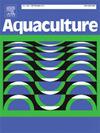Lipid droplet distribution in Atlantic salmon (Salmo salar L.) oocytes is related to the fertilisation and developmental outcome
IF 3.9
1区 农林科学
Q1 FISHERIES
引用次数: 0
Abstract
At present, there is no simple and practical applicable method to determine the quality of Atlantic salmon oocytes upon collection at the fish farm. Investigating oocyte lipid droplet patterns might be a tool for the aquaculture industry to predict oocyte quality in Atlantic salmon. While examining the lipid distribution in oocyte batches from 16 females of Atlantic salmon with a range in fertilisation rate (6–97 %), five categories of lipid droplet patterns were distinguished. In category 1, the lipid droplets were evenly distributed whereas in the remaining categories lipid droplets showed varying degree of coalescence. Categories 2, 3, 4 and 5 were distinguished based on the area of coalesced lipid droplets. The fertilisation rate was observed to be high (≥ 90 %), in females that had more oocytes from category 1, 2 and 3 whereas females with more oocytes from category 4 and 5 showed a low fertilisation rate (<90 %). A similar pattern was revealed between lipid droplet categories and eyed embryo and hatching success. Staining of salmon oocytes further confirmed the observed lipid droplet patterns, and different sizes of lipid droplets were present in almost all oocytes. The study revealed a significant association between lipid droplet category and fertilisation outcome in oocytes of Atlantic salmon that can be a practical tool for predicting oocyte quality.
大西洋鲑(Salmo salar L.)卵母细胞中的脂滴分布与受精和发育结果有关
目前,还没有简单实用的方法来确定在养鱼场采集的大西洋鲑卵母细胞的质量。调查卵母细胞脂滴形态可能是水产养殖业预测大西洋鲑卵母细胞质量的一种工具。在研究受精率(6-97%)不等的 16 尾雌性大西洋鲑卵母细胞的脂质分布时,发现了五类脂滴形态。在第 1 类中,脂滴分布均匀,而在其余类别中,脂滴呈现不同程度的凝聚。第 2、3、4 和 5 类是根据凝聚脂滴的面积区分的。观察发现,1、2 和 3 类卵母细胞较多的雌性受精率较高(≥ 90 %),而 4 和 5 类卵母细胞较多的雌性受精率较低(<90 %)。脂滴类别与眼胚和孵化成功率之间也存在类似的模式。对鲑鱼卵母细胞的染色进一步证实了观察到的脂滴模式,几乎所有卵母细胞中都存在不同大小的脂滴。该研究揭示了大西洋鲑鱼卵母细胞脂滴类别与受精结果之间的重要关联,可作为预测卵母细胞质量的实用工具。
本文章由计算机程序翻译,如有差异,请以英文原文为准。
求助全文
约1分钟内获得全文
求助全文
来源期刊

Aquaculture
农林科学-海洋与淡水生物学
CiteScore
8.60
自引率
17.80%
发文量
1246
审稿时长
56 days
期刊介绍:
Aquaculture is an international journal for the exploration, improvement and management of all freshwater and marine food resources. It publishes novel and innovative research of world-wide interest on farming of aquatic organisms, which includes finfish, mollusks, crustaceans and aquatic plants for human consumption. Research on ornamentals is not a focus of the Journal. Aquaculture only publishes papers with a clear relevance to improving aquaculture practices or a potential application.
 求助内容:
求助内容: 应助结果提醒方式:
应助结果提醒方式:


